All the increased revenue goes straight to increasing your net profit as you’ve not added any costs – it’s pure profit.
Sounds wonderful, but increase your prices too much, you become uncompetitive, customers start walking and you lose profit. In economics this is referred to as price elasticity.
If you raise your price by y%, how many customers can you lose and still make the same profit?
The numbers are all going to depend on your specific financial profile but we’ll go through 2 examples to see the differences. One with a gross profit margin of 40%. And another with a gross margin of 70%.
The impact on price increases is easy to work out: Just take your revenue and multiply by the percent change in your price.
As there are no additional costs this increased revenue goes straight to your net profit, and can result in massive percent based net profit changes (that’s why you need to use your skepticism when people talk in percentage changes in their business).
Below we’ve calculated a 5% increase in price. On a million dollar revenue, that’s an extra $50,000 net profit (with no change in volume sold). In this example, that’s a net profit increase of 12.5%
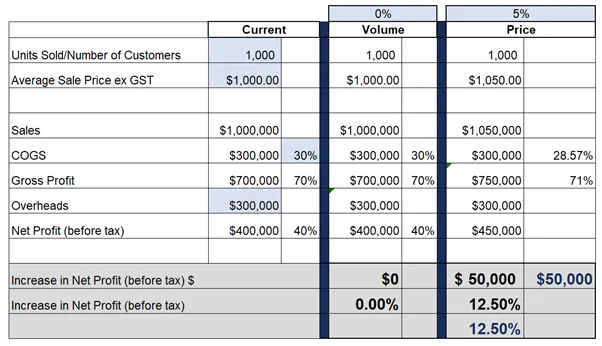
Now with a bit of excel sorcery we can work out what percent volume loss we would need to suffer and be in the same profit position as before ($400,000).
In this example, sales volume would have to fall 7% to offset the rise in prices.
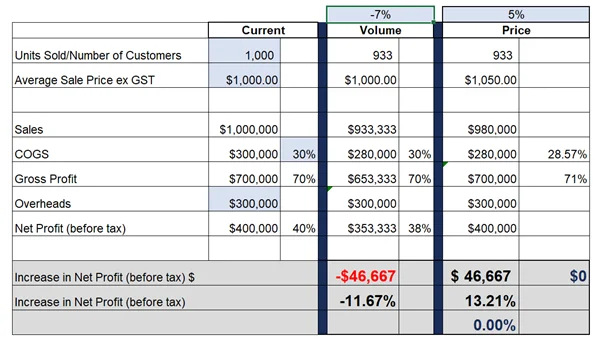
And in a business with a lot lower gross profit percent, in this case a 40% Gross Profit, it would take an 11% drop in volume to offset a 5% increase in price.
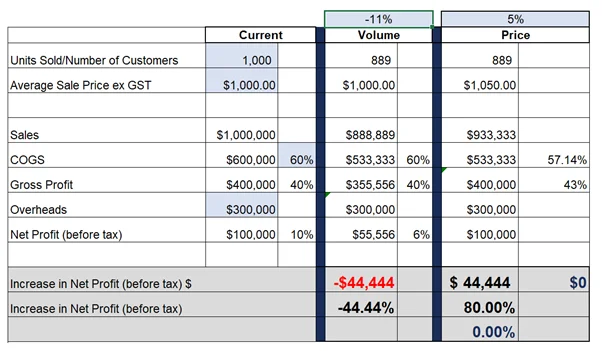
The reality is, we never know how many customers will walk due to price increases until they’ve actually walked. So this pure numbers based approach is fairly high risk. The downside could be you lose a lot more customers (volume) and profit falls. Then you’ll need to work really hard on sales to replace them.
Related Content
On the flip side, you might be over-stating (fearing) that customers won’t bear a price increase and be pleasantly surprised that most just stay.
Let’s say you only lose 3% of customers here’s what that looks like at both a 70% and 40% Gross Profit margin;
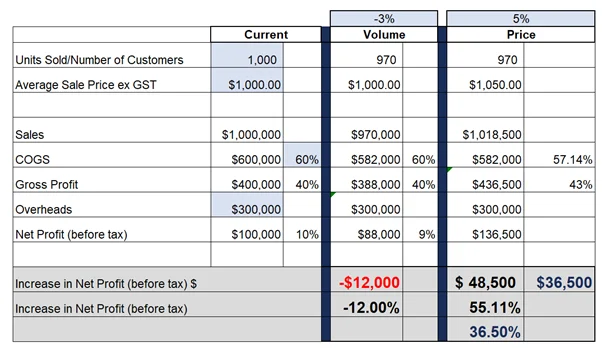
40% gross profit 3% volume decrease and 5% price increase
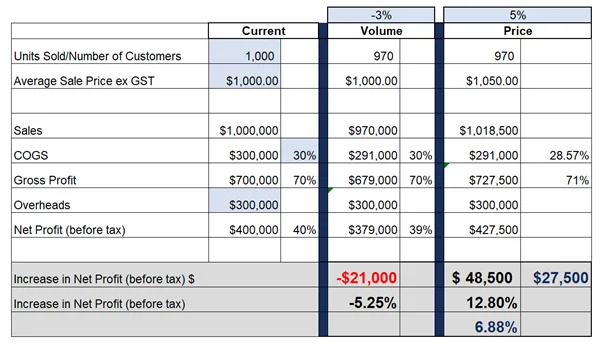
70% gross profit with 3% volume decrease and 5% price increase
So how can you work this out? Here’s a couple of strategies;
Well for a service based business, you’ll know the customers at a personal level and how “price sensitive” they are.
There’s likely a cohort of clients that you could do without and by going through your client list, you could work out with a fairly high degree of certainty the ones who will be;
1. About time you put your prices up!
2. No worries
3. I can’t believe you’re doing this. I’m going somewhere else
And for all new customers put them straight on the new pricing structure and they won’t know any different.
Product Based Business
For a product-based business, it’s a bit harder, but here’s some strategies;
E-commerce Business
- Run a special ad campaign, targeting a small audience with the new pricing. Compare the conversion rates to that of existing campaigns and see what the differences are. If they’re acceptable, increase the audience size and continue to monitor
- Create a higher priced new product, target your existing customer base and compare against your existing sales conversion rates
Local Business (like a cafe)
It’s unlikely that someone isn’t going to buy that bacon and egg roll because you put your price up $0.50 – unless you’re in a highly competitive area and substitute cafes or products are within easy reach.
You May Also Like
So my advice would be to give it a go. Increase your prices for a day, week, month and compare and assess the results. Monitor volume of sales closely, if it is doing damage you can revert to the original pricing and will then know where the price ceiling currently is.
At the end of the day, prices increase.
The price of milk and groceries aren’t the same as they were 10 years ago.
The rent you pay goes up, wages you pay go up.
Your prices need to go up. We’re not talking about doubling the price of everything here. As the example above showed, a 5% increase in price can add ten’s of thousands to your profit. And don’t forget a 5% increase is going from $1 to $1.05, from $10 to $10.50, from $100 to $105.
Don’t let fear drive you. If you make your price increases reasonable while still being competitive for quality, service, and speed your customers will get it.
Make dramatic sweeping changes however and they may be a little less forgiving.
At the end of the day if you aren’t getting paid what you think you deserve, you could be tempted to start cutting corners, quality drops and then the pricing will be right for what you’re producing.
If you’re not getting the appropriate financial rewards, its likely you’ll end up exiting the business, and customers will ultimately lose out and have to go somewhere else.
But if you can keep prices at an appropriate level by making adjustments each year or so, then you get paid, customers get their desired outcome and it’s win win for everyone.
Need help with your numbers? Check out our business consulting, or get in touch here.
